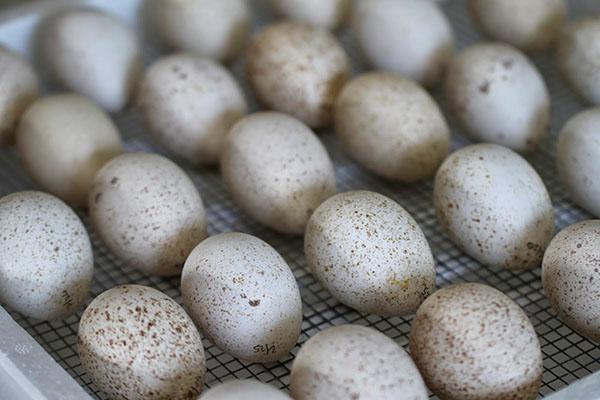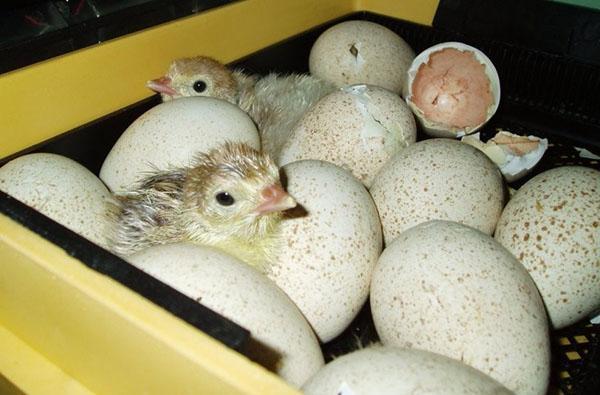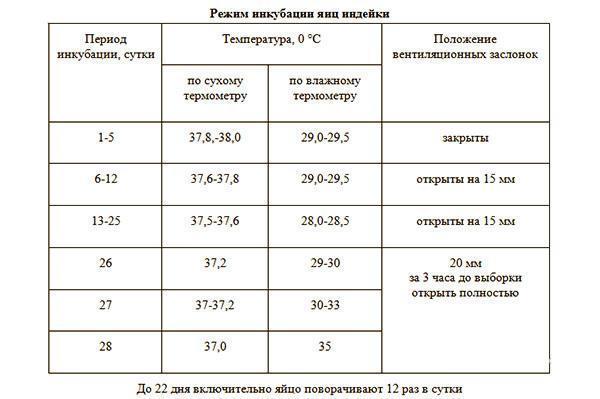At home, you can independently remove turkey poults in an incubator
 Breeding of poultry is possible even in small household plots. Unable to maintain an adult herd, the owners of the farmstead use the hatching of turkey poults at home in an incubator.
Breeding of poultry is possible even in small household plots. Unable to maintain an adult herd, the owners of the farmstead use the hatching of turkey poults at home in an incubator.
The formation and development of the embryo starts inside the body of the laying hen. When the egg is laid, the further growth rate of the future chick depends entirely on external conditions.
Features of turkey incubation and preparation for it
Eggs intended for incubation from under the birds are taken hourly and immediately transferred to storage. Eggs are placed on trays with the sharp end down, which saves space and creates all the conditions for moving the air lens to the upper, blunt part.
So that at the moment of entering the incubator all the embryos are at the same stage of development, and their hatching is as friendly as possible, the eggs are kept cool with constant air ventilation and high humidity.
The most suitable conditions for this:
- temperature 10-15 ° C;
- humidity in the range of 60–89%.

Perfectly adapted to this complex mission, birds better than any automatic incubator cope with maintaining the required temperature and humidity, they turn and roll eggs up to 50 times per day so that the entire clutch of fifteen eggs is heated evenly.
This work is most important at the first stage of embryo development. Then the eggs themselves become sources of heat, and here the turkey has to get up more often so that her future children receive enough air, there is no threat of mold and mildew in the nest.
Hatchery atmosphere for hatching turkeys at home
For novice poultry farmers, the question is always relevant: "How many days will the turkey poults hatch into the world?"
On average, 28 days pass from the moment the chick hatches out of the egg for incubation. This is a few days earlier than the withdrawal goslings... But such a time is relative, since several factors at once influence the period:
- the size and original quality of the hatched eggs;
- coordination of the real and indicated in the table temperature regimes for turkeys;
- compliance with other conditions for caring for the egg, including airing and maintaining the right humidity.

As a rule, the first signs of the appearance of chicks can be seen on the 26th day. Moreover, turkey poults of light lines are hatched earlier than their large heavy counterparts.
At home, in an incubator, the hatching of turkey poults from the first hatching to the release of the last chick from the shell takes up to two days. Delaying deadlines signals potential problems.
Selection of turkey eggs for incubation
Eggs intended for incubation of turkeys are selected in advance so that the batch being laid is as homogeneous and high quality as possible. Experienced poultry farmers consider the criteria for the selection of eggs:
- size, inside too small or large eggs there are sometimes weak or non-viable embryos;
- the shape that affects the position of the embryo, its development and the success of hatching;
- the quality of the shell, which should be smooth, without microcracks, sagging, spotting and other defects.
 However, the appearance cannot guarantee that the egg is fertilized and does not have internal defects invisible at first glance.
However, the appearance cannot guarantee that the egg is fertilized and does not have internal defects invisible at first glance.
To control the state of the embryo, candling is used - transillumination. This method helps to identify cracks in the shell, malformations of the embryo, to examine the volume and position of the air chamber, which the chick uses for breathing until it hatches.
In the early stages and before setting in the incubator, the yolk becomes the subject of study. A high-quality egg suitable for hatching turkey poults in an incubator at home has the yolk:
- at rest, centered;
- has unclear blurred boundaries;
- as a result of turning, the egg moves inside the volume, but then restores its previous position.
When the selected egg enters the incubator, it is also not left unattended. The development of the embryo has to be assessed at least twice, and it is better to do this every week, for example, on the eighth, fifteenth day, as well as at the time of transferring eggs to hatcher trays. This is done on the 25th day after the start of incubation.
How is turkey hatching going in an incubator at home?
The activation of the embryo when it enters the incubator occurs due to an increase in temperature and humidity. Artificially created conditions mimic the incubation of turkey eggs. But if in the natural environment the main concerns fall on the bird, then at home, when hatching turkey poults in an incubator, a person takes on the main role.
 The main task is to maintain and timely correct temperature and humidity levels. To do this, it is convenient to use the incubator temperature table developed for turkey eggs above. In this case, it is necessary:
The main task is to maintain and timely correct temperature and humidity levels. To do this, it is convenient to use the incubator temperature table developed for turkey eggs above. In this case, it is necessary:
- regularly monitor the status of the bookmark;
- turn the trays 12 times up to transfer to the output;
- airing according to the recommendations;
- starting from the 9th day, cool the masonry, gradually increasing the time from 5 minutes to half an hour twice a day;
- monitor the humidity and daily, and from the 22nd day twice, spray the egg with warm water.
On the 25th day, the egg is transferred to hatcher trays and ventilation is increased. With the beginning of the mass appearance of turkey poults, it is important to control the condition of both hatching chicks and individuals already ready for independent life.
 6 hours after hatching, the birds are examined and sorted.
6 hours after hatching, the birds are examined and sorted.
Incubating turkeys is a troublesome business that requires skill and experience. But with a certain diligence and attention to the needs of the bird, the first brood will please both with a quick weight gain and health.